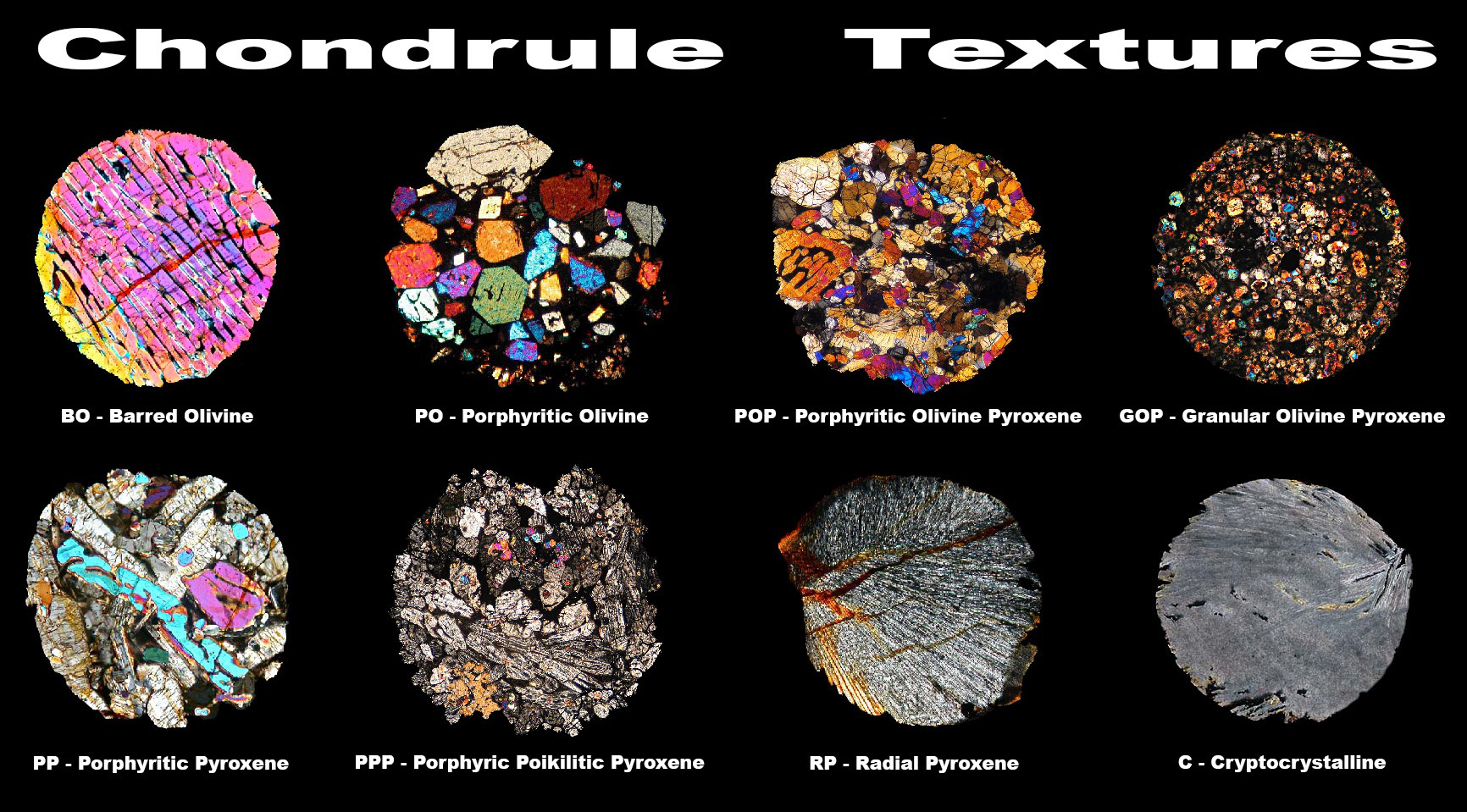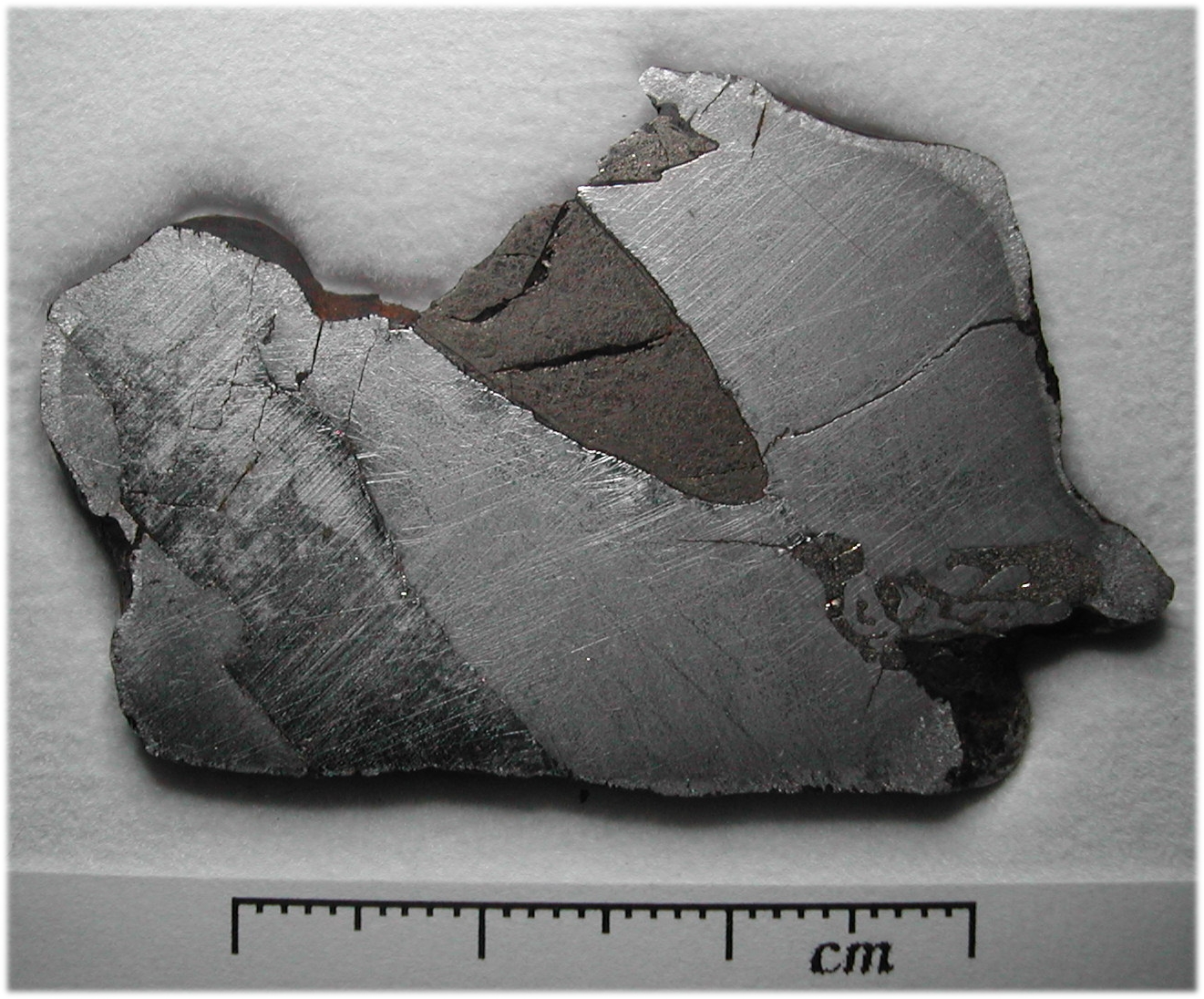|
Pultusk (meteorite)
Pultusk is an H chondrite, H5 ordinary chondrite meteorite which fell on 30 January 1868 in Poland. The event has been known as the stony meteorite shower with the largest number of pieces yet recorded in history. Made up of rocky debris, it consists of pyroxene or olivine chondrules deployed in mass plagioclase, there being also kamacite. History The fall occurred on January 30, 1868 at 7:00 pm near the town of Pułtusk, about northeast of Warsaw. Thousands of people witnessed a large fireball followed by detonations and a very large shower of small fragments falling on ice, land and houses within an area of about 127 sq km (appx. 78 sq. miles). The estimated number of fragments was 68780.This statement has been contradicted by authors and scholars in the field of meteorite studies who estimated the number of fragments to be over 100.000, while other researchers have mentioned a misreading during the analysis of the chemical components and that a more precise number wou ... [...More Info...] [...Related Items...] OR: [Wikipedia] [Google] [Baidu] |
Chondrite
A chondrite is a stony (non-metallic) meteorite that has not been modified, by either melting or differentiation of the parent body. They are formed when various types of dust and small grains in the early Solar System accreted to form primitive asteroids. Some such bodies that are captured in the planet's gravity well become the most common type of meteorite by (whether quickly, or after many orbits) arriving on a trajectory toward the planet's surface. Estimates for their contribution to the total meteorite population vary between 85.7% and 86.2%. Their study provides important clues for understanding the origin and age of the Solar System, the synthesis of organic compounds, the origin of life and the presence of water on Earth. One of their characteristics is the presence of chondrules (from the Ancient Greek χόνδρος ''chondros'', grain), which are round grains formed as molten, or partially molten droplets, in the space by distinct minerals, that normally consti ... [...More Info...] [...Related Items...] OR: [Wikipedia] [Google] [Baidu] |
Chondrule
A chondrule (from Ancient Greek χόνδρος ''chondros'', grain) is a round grain found in a chondrite. Chondrules form as molten or partially molten droplets in space before being accreted to their parent asteroids. Because chondrites represent one of the oldest solid materials within the Solar System and are believed to be the building blocks of the planetary system, it follows that an understanding of the formation of chondrules is important to understand the initial development of the planetary system. Abundance and size Different kinds of the stony, non-metallic meteorites called chondrites contain different fractions of chondrules (see table below). In general, carbonaceous chondrites contain the smallest percentage (by volume) of chondrules, including the CI chondrites which, paradoxically, do not contain ''any'' chondrules despite their designation as chondrites, whereas ordinary and enstatite chondrites contain the most. Because ordinary chondrites represent 80% o ... [...More Info...] [...Related Items...] OR: [Wikipedia] [Google] [Baidu] |
1860s In Science
Year 186 ( CLXXXVI) was a common year starting on Saturday (link will display the full calendar) of the Julian calendar. At the time, it was known as the Year of the Consulship of Aurelius and Glabrio (or, less frequently, year 939 ''Ab urbe condita''). The denomination 186 for this year has been used since the early medieval period, when the Anno Domini calendar era became the prevalent method in Europe for naming years. Events By place Roman Empire * Peasants in Gaul stage an anti-tax uprising under Maternus. * Roman governor Pertinax escapes an assassination attempt, by British usurpers. New Zealand * The Hatepe volcanic eruption extends Lake Taupō and makes skies red across the world. However, recent radiocarbon dating by R. Sparks has put the date at 233 AD ± 13 (95% confidence). Births * Ma Liang, Chinese official of the Shu Han state (d. 222) Deaths * April 21 – Apollonius the Apologist, Christian martyr * Bian Zhang, Chinese official and gener ... [...More Info...] [...Related Items...] OR: [Wikipedia] [Google] [Baidu] |
1868 In Poland
Events January–March * January 2 – British Expedition to Abyssinia: Robert Napier leads an expedition to free captive British officials and missionaries. * January 3 – The 15-year-old Mutsuhito, Emperor Meiji of Japan, declares the ''Meiji Restoration'', his own restoration to full power, under the influence of supporters from the Chōshū and Satsuma Domains, and against the supporters of the Tokugawa shogunate, triggering the Boshin War. * January 5 – Paraguayan War: Brazilian Army commander Luís Alves de Lima e Silva, Duke of Caxias enters Asunción, Paraguay's capital. Some days later he declares the war is over. Nevertheless, Francisco Solano López, Paraguay's president, prepares guerrillas to fight in the countryside. * January 7 – The Arkansas constitutional convention meets in Little Rock. * January 9 – Penal transportation from Britain to Australia ends, with arrival of the convict ship ''Hougoumont'' in Western Australia, ... [...More Info...] [...Related Items...] OR: [Wikipedia] [Google] [Baidu] |
Meteorites Found In Poland
A meteorite is a solid piece of debris from an object, such as a comet, asteroid, or meteoroid, that originates in outer space and survives its passage through the atmosphere to reach the surface of a planet or moon. When the original object enters the atmosphere, various factors such as friction, pressure, and chemical interactions with the atmospheric gases cause it to heat up and radiate energy. It then becomes a meteor and forms a fireball, also known as a shooting star; astronomers call the brightest examples " bolides". Once it settles on the larger body's surface, the meteor becomes a meteorite. Meteorites vary greatly in size. For geologists, a bolide is a meteorite large enough to create an impact crater. Meteorites that are recovered after being observed as they transit the atmosphere and impact the Earth are called meteorite falls. All others are known as meteorite finds. Meteorites have traditionally been divided into three broad categories: stony meteorites that ... [...More Info...] [...Related Items...] OR: [Wikipedia] [Google] [Baidu] |
Google Books
Google Books (previously known as Google Book Search, Google Print, and by its code-name Project Ocean) is a service from Google Inc. that searches the full text of books and magazines that Google has scanned, converted to text using optical character recognition (OCR), and stored in its digital database.The basic Google book link is found at: https://books.google.com/ . The "advanced" interface allowing more specific searches is found at: https://books.google.com/advanced_book_search Books are provided either by publishers and authors through the Google Books Partner Program, or by Google's library partners through the Library Project. Additionally, Google has partnered with a number of magazine publishers to digitize their archives. The Publisher Program was first known as Google Print when it was introduced at the Frankfurt Book Fair in October 2004. The Google Books Library Project, which scans works in the collections of library partners and adds them to the digital invent ... [...More Info...] [...Related Items...] OR: [Wikipedia] [Google] [Baidu] |
Museum Of Technology, Warsaw
Muzeum Techniki w Warszawie is a museum in Warsaw, Poland. It was established in 1955. It is located in the Palace of Culture & Science. Exhibits include motorbikes, aeroplanes, 19th century musical boxes, and historic cars. References External links * * Technology Technology is the application of knowledge to reach practical goals in a specifiable and reproducible way. The word ''technology'' may also mean the product of such an endeavor. The use of technology is widely prevalent in medicine, science, ... Museums established in 1955 Technology museums Science museums in Poland 1955 establishments in Poland {{Warsaw-struct-stub ... [...More Info...] [...Related Items...] OR: [Wikipedia] [Google] [Baidu] |
Sikhote-Alin (meteorite)
An iron meteorite fell on the Sikhote-Alin Mountains, in southeastern Russia, in 1947. Large iron meteorite falls have been witnessed and fragments recovered but never before, in recorded history, a fall of this magnitude. An estimated 23 tonnes of fragments survived the fiery passage through the atmosphere and reached the Earth. Impact At around 10:30 AM on 12 February 1947, eyewitnesses in the Sikhote-Alin Mountains, Primorye, Soviet Union, observed a large bolide brighter than the sun that came out of the north and descended at an angle of about 41 degrees. The bright flash and the deafening sound of the fall were observed for around the point of impact not far from Luchegorsk and approximately northeast of Vladivostok. A smoke trail, estimated at long, remained in the sky for several hours. As the meteor, traveling at a speed of about , entered the atmosphere, it began to break apart, and the fragments fell together, some burying themselves deep. At an altitude of abou ... [...More Info...] [...Related Items...] OR: [Wikipedia] [Google] [Baidu] |
Glossary Of Meteoritics
This is a glossary of terms used in meteoritics, the science of meteorites. # * 2 Pallas – an asteroid from the asteroid belt and one of the likely parent bodies of the CR meteorites. * 4 Vesta – second-largest asteroid in the asteroid belt and likely source of the HED meteorites. * 221 Eos – an asteroid from the asteroid belt and one of the likely parent bodies of the CO meteorites. * 289 Nenetta – an asteroid from the asteroid belt and one of the likely parent bodies of the angrites. * 3103 Eger – an asteroid from the asteroid belt and one of the likely parent bodies of the aubrites. * 3819 Robinson – an asteroid from the asteroid belt and one of the likely parent bodies of the angrites. * IA meteorite – an iron meteorite group now part of the IAB group/complex. * IAB meteorite – an iron meteorite and primitive achondrite of the IAB group/complex. * IB meteorite – an iron meteorite group now part of the IAB group/complex. * IC meteorite – an ... [...More Info...] [...Related Items...] OR: [Wikipedia] [Google] [Baidu] |
Chromite
Chromite is a crystalline mineral composed primarily of iron(II) oxide and chromium(III) oxide compounds. It can be represented by the chemical formula of FeCr2O4. It is an oxide mineral belonging to the spinel group. The element magnesium can substitute for iron in variable amounts as it forms a solid solution with magnesiochromite (MgCr2O4). A substitution of the element aluminium can also occur, leading to hercynite (FeAl2O4). Chromite today is mined particularly to make stainless steel through the production of ferrochrome (FeCr), which is an iron-chromium alloy. Chromite grains are commonly found in large mafic igneous intrusions such as the Bushveld in South Africa and India. Chromite is iron-black in color with a metallic luster, a dark brown streak and a hardness on the Mohs scale of 5.5. Properties Chromite minerals are mainly found in mafic-ultramafic igneous intrusions and are also sometimes found in metamorphic rocks. The chromite minerals occur in layered format ... [...More Info...] [...Related Items...] OR: [Wikipedia] [Google] [Baidu] |
Troilite
Troilite is a rare iron sulfide mineral with the simple formula of FeS. It is the iron-rich endmember of the pyrrhotite group. Pyrrhotite has the formula Fe(1-x)S (x = 0 to 0.2) which is iron deficient. As troilite lacks the iron deficiency which gives pyrrhotite its characteristic magnetism, troilite is non-magnetic. Troilite can be found as a native mineral on Earth but is more abundant in meteorites, in particular, those originating from the Moon and Mars. It is among the minerals found in samples of the meteorite that struck Russia in Chelyabinsk on February 15th, 2013. Uniform presence of troilite on the Moon and possibly on Mars has been confirmed by the Apollo, Viking and Phobos space probes. The relative intensities of isotopes of sulfur are rather constant in meteorites as compared to the Earth minerals, and therefore troilite from Canyon Diablo meteorite is chosen as the international sulfur isotope ratio standard, the Canyon Diablo Troilite (CDT). Structure Troilit ... [...More Info...] [...Related Items...] OR: [Wikipedia] [Google] [Baidu] |






